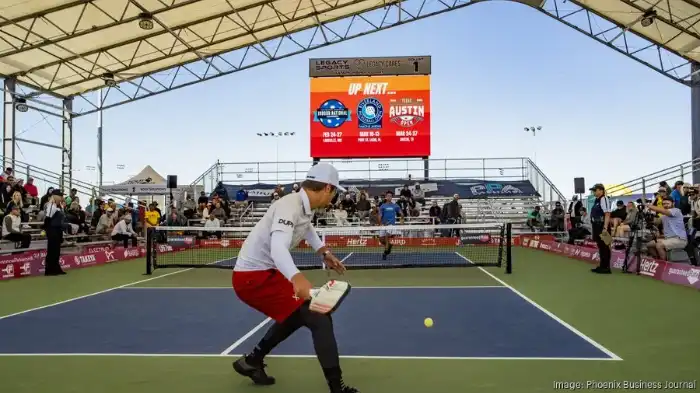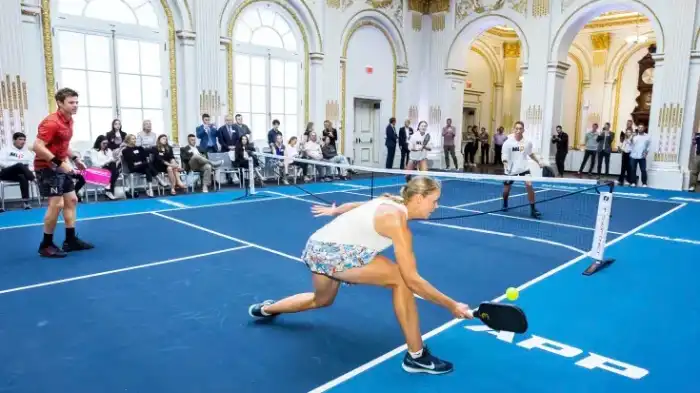When did pickleball become a sport? It’s a question that often crosses the minds of those who have witnessed the meteoric rise of this beloved pastime. From its humble beginnings in a backyard on Bainbridge Island, Washington, to becoming an internationally recognized sport, the journey of pickleball is a remarkable one. In this blog, we’ll delve into the fascinating history of pickleball, tracing its evolution from a casual family game to a highly competitive sport with a global following.
The Birth of Pickleball
The story of pickleball begins on Bainbridge Island, Washington, in the summer of 1965. Joel Pritchard, a U.S. Congressman, and his friend Bill Bell returned home to find their families bored and restless. In an attempt to entertain their kids, they came up with the idea of a new game. Using some badminton equipment, a whiffle ball, and the lower badminton net, they improvised a sport that was both fun and engaging.
Initially, they referred to the game as “paddle tennis” due to its similarities to tennis. However, they later named it “pickleball,” a term often associated with the Pritchard family’s dog, Pickles, who had a knack for chasing after stray balls. This whimsical name stuck, and the sport gained popularity on Bainbridge Island.
Pickleball’s Transition to a Sport
Pickleball was born as a recreational backyard game, but it didn’t take long for it to evolve into something more significant. Its growth beyond the Pritchard’s backyard can be attributed to the efforts of Barney McCallum, another friend of Joel Pritchard’s. McCallum, who was instrumental in introducing the sport to other communities, helped to formalize the rules and create a set of guidelines that allowed for competitive play.

In 1972, the first-ever pickleball tournament took place in Tukwila, Washington, solidifying the game’s status as a competitive sport. Over the years, the sport continued to gain traction, spreading to different parts of the United States and eventually reaching international shores.
The United States Pickleball Association (USAPA), established in 1984, played a crucial role in promoting pickleball as a legitimate sport. They introduced standardized rules, equipment regulations, and sanctioned tournaments. With the USAPA’s support, pickleball was no longer a casual backyard game but a sport with defined rules, a ranking system, and a growing community of players.
Renaissance of Pickleball
During the early 2000s, pickleball saw a resurgence in popularity, drawing international interest. Countries like Canada, the United Kingdom, and Australia began to enthusiastically adopt the sport, contributing to its global expansion. This led to the formation of the International Federation of Pickleball (IFP) in 2010, which aimed to promote the sport globally and establish consistent rules and standards.
With the IFP’s efforts, pickleball quickly spread beyond recreational circles and began attracting serious athletes. The establishment of professional pickleball tours, such as the Professional Pickleball Association (PPA) and the USA Pickleball Association (USAPA), brought more legitimacy and resources to the sport. These tours featured highly skilled players and offered substantial prize money, further fueling the growth and competitiveness of pickleball.
The Current State of Pickleball
Today, pickleball is thriving as a competitive sport. It has transitioned from a casual backyard game to an organized, professional endeavor. The sport is played on dedicated courts with specific dimensions and surfaces. Pickleball equipment has also evolved, with manufacturers developing specialized paddles and balls designed for optimal performance.
Moreover, pickleball has gained media attention, with major sports networks broadcasting tournaments and competitions. The sport has also made its way into senior communities, schools, and even retirement homes, proving to be accessible to players of all ages and skill levels.

Future of Pickleball
The future of pickleball looks bright. With its widespread popularity and continuous growth, the sport is likely to gain even more recognition and acceptance on a global scale. The inclusion of pickleball in multi-sport events, such as the Asian Games, is being explored, which could further elevate its status and reach.
As the sport evolves, there will be efforts to standardize rules, enhance training programs, and attract top-tier talent. Pickleball will continue to refine its professional circuits and establish itself as a competitive sport with its unique charm.
Frequently Asked Questions
While originating in the United States, pickleball has gained popularity worldwide. Thanks to the internet and social media, the sport’s growth has accelerated, connecting enthusiasts from different countries. As a result, international tournaments have emerged, and national pickleball associations have been established to promote the sport, leading to an ever-expanding global community of passionate pickleball players.
Yes, pickleball has transitioned into the professional realm. The sport now boasts professional players who compete in high-stakes tournaments, attracting both recreational players and aspiring professionals. The formation of professional organizations, such as the Professional Pickleball Association (PPA) and the Association of Pickleball Professionals (APP), has provided a platform for skilled players to showcase their talents, earn sponsorships, and make a career out of playing pickleball.
No, pickleball has gained international popularity, with countries around the world embracing the sport. The formation of the International Federation of Pickleball (IFP) in 2010 further facilitated the global spread of pickleball.
Pickleball officially transitioned from a backyard game to a sport in 1984 with the establishment of the United States Pickleball Association (USAPA). USAPA played a pivotal role in standardizing the rules and promoting the sport’s competitive side, giving it the recognition it deserved. Since then, pickleball has continued to grow as a legitimate sport, both nationally and internationally.
Conclusion
In the journey from being a whimsical backyard game to a fully-fledged sport, pickleball has come a long way. Its evolution from the question of “when did pickleball become a sport” to a widely recognized and cherished activity is a testament to the passion and dedication of its players and enthusiasts. As we look ahead, the future of pickleball appears promising, with the sport poised to gain further recognition and acceptance on the global stage, solidifying its place as a beloved sport for generations to come.

